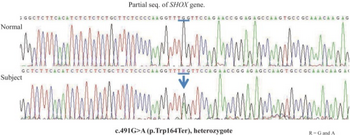Léri–Weill dyschondrosteosis
| Léri–Weill dyschondrosteosis | |
|---|---|
| Other names: LWD | |
 | |
| Léri–Weill dyschondrosteosis is inherited in an autosomal dominant manner | |
Léri–Weill dyschondrosteosis or LWD is a rare pseudoautosomal dominant genetic disorder which results in dwarfism with short forearms and legs (mesomelic dwarfism) and a bayonet-like deformity of the forearms (Madelung's deformity).[1]
Signs and symptoms
The clinical presentation of this condition is consistent with short stature and wrist deformity[2]
Causes

It is caused by mutations in the short-stature homeobox gene found in the pseudoautosomal region PAR1 of the X and Y chromosomes, at band Xp22.33 or Yp11.32.[3]
SHOX gene deletions have been identified as the major cause of Leri–Weill syndrome.[4]
Leri–Weill dyschondrosteosis is characterized by mesomelic short stature, with bowing of the radius more so than the ulna in the forearms and bowing of the tibia while sparing the fibula.[citation needed]
Diagnosis
Diagnosis is made following genetic blood testing.[citation needed]
Treatment
In terms of management, there is administration of recombinant human growth hormone. Wrist splints, and ergonomic devices for wrist discomfort.[2]
History
LWD was first described in 1929 by André Léri and Jean A. Weill.[5][6]
References
- ↑ Benito-Sanz S, Thomas NS, Huber C, et al. (October 2005). "A Novel Class of Pseudoautosomal Region 1 Deletions Downstream of SHOX Is Associated with Léri–Weill Dyschondrosteosis". Am. J. Hum. Genet. 77 (4): 533–44. doi:10.1086/449313. PMC 1275603. PMID 16175500.
- ↑ 2.0 2.1 RESERVED, INSERM US14-- ALL RIGHTS. "Orphanet: Léri Weill dyschondrosteosis". www.orpha.net. Archived from the original on 12 August 2020. Retrieved 6 July 2022.
- ↑ Gatta V, Antonucci I, Morizio E, et al. (2007). "Identification and characterization of different SHOX gene deletions in patients with Leri–Weill dyschondrosteosys by MLPA assay". J. Hum. Genet. 52 (1): 21–7. doi:10.1007/s10038-006-0074-5. PMID 17091221.
- ↑ Fukami M, Dateki S, Kato F, et al. (2008). "Identification and characterization of cryptic SHOX intragenic deletions in three Japanese patients with Léri–Weill dyschondrosteosis". J. Hum. Genet. 53 (5): 454–9. doi:10.1007/s10038-008-0269-z. PMID 18322641.
- ↑ synd/1662 at Who Named It?
- ↑ Léri A, Weill JA (1929). "Une affection congénitale et symétrique du développement osseux. La dyschondrostéose". Bulletins et Mémoires de la Société Médicale des Hôpitaux de Paris. 53: 1491–1494.
External links
| Classification | |
|---|---|
| External resources |